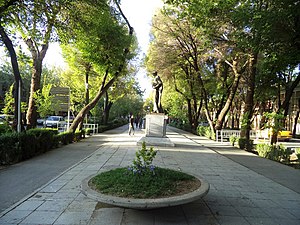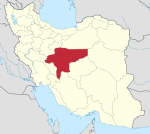|
Chaharbagh, Isfahan  Chahar Bagh Boulevard (Persian: چهارباغ, translation: Four Gardens) is a historical avenue in Isfahan constructed during the Safavid era. This historic street is very similar to the Champs-Élysées in Paris. Therefore, some visitors have called it the Champs-Élysées of Isfahan. The avenue, historically, is the most famous in all of Iran. It connects Isfahan's northern parts to the southern sections and is about 6 kilometers long. On the east side of this street, there are the Hasht Behesht and Chehel Sotoun gardens.[1] Origin of nameThe avenue was named "Chahar Bagh" because Shah Abbas the Great had bought four vineyards in the city to secure the right-of-way.[2] HistoryShah Abbas I was the shah who changed his capital from Qazvin to Isfahan and decided to concentrate the country's artistic wealth into that central spot which has been dubbed for centuries "Nesf-e Jahan" or "Half the World". The chief architect of this task of urban planning was Shaykh Bahai (Baha' ad-Din al-'Amili),[3] who focused the programme on two key features of Shah Abbas's master plan: the Chahar Bagh avenue, flanked at either side by all the prominent institutions of the city, such as the residences of all foreign dignitaries, and the Naqsh-e Jahan Square ("Exemplar of the World").[4][5] After the opening of the enghelab metro station, chaharbagh abbasi, the middle section of avenue, was pedestrianised.[1] Sections
Chaharbagh Pa'inChaharbagh Pa'in, or lower Chaharbagh, (Persian: چهارباغ پایین) is the northern section of the avenue. This part of Chaharbagh is from Shohada Square to Darvazeh Dowlat.
Chaharbagh AbbasiChaharbagh Abbasi, (Persian: چهارباغ عباسی) is the middle section of the avenue. This part of Chaharbagh is from Darvazeh Dowlat to Northern 33 pol at Enqelab Square.
Chaharbagh BalaChaharbagh Bala, or upper Chaharbagh, (Persian: چهارباغ بالا) is the southern section of the avenue. This part of Chaharbagh is from southern 33 pol to Azadi Square.
References
Wikimedia Commons has media related to Chaharbagh (Isfahan). |
|||||||||||||||||||||||||||||||||||||||||||||||||||||||||||||||||||||||||||||||||||||||||||||||||||||||||

